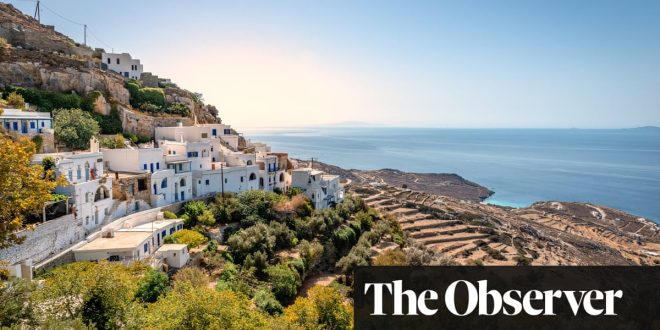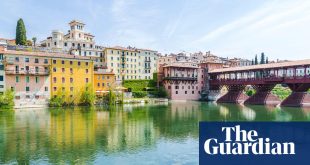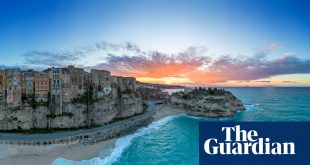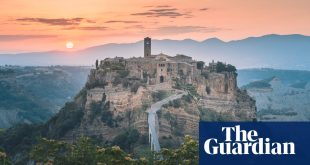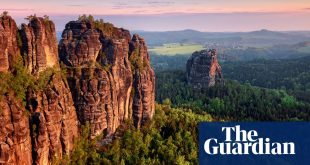A woman crawls, slowly – very slowly – along the pavement. She’s wearing kneepads. Before her walks her husband, carrying a red candle as tall as himself. On the main steps to the church of Panagia Evangelistria, we pass two more people proceeding on hands and knees. But this is not a surprise: we are on the island of Tinos, outside one of the holiest sites in Greece. If we’d come in August, there’d have been many more pilgrims crawling uphill, over 800m, all the way from the island’s main port, in sweltering heat.
The church they’re inching towards is a neoclassical marble beauty with wedding-cake decorations of blue and red. Inside, black-cloaked priests chant in candlelight and clouds of incense. Even for the irreligious, it’s a moving experience to see pilgrims, many of them now in tears, queueing to kiss the holy icon, said to have been discovered after a local nun had a vision from the Virgin Mary.
Tinos, in the Cycladic archipelago, is a rugged isle with zigzagging Bronze Age terraces and ornate dovecotes left by the Venetians. The northern wind, known as the Meltemi, is our constant companion. It whips at our hair and threatens to wrench the doors off our tiny rental car. But we come to love the wind, because it keeps the intense summer heat at bay and lends a wild, untamed beauty to the landscape.
When we arrive at our hotel, it takes two members of staff to wrestle the heavy sliding door open against a 60mph gale. We are staying at the Odera, the first boutique hotel on the island. Tucked into the turquoise cove of Vourni beach and accessed by a long and rough dirt track, it’s been designed to minimise its impact on the landscape.
It would be easy to spend our whole stay here, enjoying the hotel’s gorgeous spa, eating Greek salad at the beach bar and watching goats frolic in nearby fields. The view is spectacular: intense blues of sea and sky speckled every few hours by a distant ferry tracking the horizon.
But Tinos has much to explore. We book a guide: the charming Zaf Gkyzis, who grew up here, has a passion for the place and seems to know everyone. He takes us to explore a few of the 60 or so villages on the island. First is Volax, perched on a hilltop and famous for basket-weaving and its other-worldly lunar landscape. We lunch in a simple taverna by the sandy beach at Kolymbithra. Kardiani, in the mountains, has brightly painted doors, marble fountains and sweeping views. The old port of Panormos is full of tempting seafood restaurants overlooking the harbour. And perhaps most impressive of all is the largest village, Pyrgos, built during the 18th and 19th centuries, when the quarrying of white and green marble brought great prosperity. The whole village glistens. The cemetery is packed with tombs of exquisite beauty. Even the bus stop is a kind of grand marble temple. The celebrated sculptor Yannoulis Chalepas used to live here. His house is now a museum and the tradition continues with several sculptors working in the village.
Always, the wind is with us. At the top of a hill outside the village of Isternia we stop to admire windmills – elsewhere on the island we have seen them converted into homes. Gkyzis says something about this, but we can hardly hear each other. “Don’t make a house in a windmill,” he says again. “They are put where they are for a reason!”
All week, we feast on Tinian cuisine at family-run tavernas: lamb with lemon and orzo at Horeftra in the hilltop village of Kampos; shrimps on the grill at the beachfront Like Salt; stuffed vine leaves and beetroot salad at Botilia in the centre of town – sipping piney mastika liqueur and watching the cats that seem to rule the island. After five days, I feel we’ve only scratched the surface. I long to return to the villages – and to swim at Vourni beach one more time. But it’s time to move on, with a ferry to Mykonos.
After the tranquillity of Tinos, the famous party island is a jolt – all club music and glitzy boutiques. But there are ways to get the best of Mykonos. If you get up very early you can wander the quieter streets of the old harbour, known as Little Venice, before the cruise ships arrive.
And you can discover another side to the island by heading just a few kilometres inland, away from the coast. At Rizes (translated as “roots”), an organic working farm by the peaceful village of Ano Mera, we eat lamb cooked on a wood fire, and explore the chicken coops and vineyards. “We are a home: expanded to welcome visitors, but still a home,” says owner Nikos Zouganelis.
Dinner is very different. Deos is a glamorous new hotel and restaurant owned by the Daktylides family, who were among the very first hoteliers on the island. Chef Ilias Maslaris delivers a fantastically creative interpretation of traditional Greek cuisine, which we enjoy from a sweeping terrace overlooking Tinos, Syros and… Delos, the reason we’ve come to Mykonos.
The tiny island of Delos is a Unesco world heritage site first settled in the third millennium BC. Its historic importance is hinted at by the name of the Cycladic islands, which form a circle around it. It can be reached from other islands, but the atmospheric 30-minute ferry from Mykonos is faster and more frequent (€25pp return from the kiosk at the harbour).
Relatively small numbers of people bother to take this journey. Today, Mykonos draws more than 2 million visitors a year. Just 120,000 visit Delos. But for most of recorded history, Mykonos was a mere satellite of wealthy, sacred Delos where, according to Greek myth, Leto gave birth to Artemis and Apollo. From the 9th century BC, pilgrims from all over the Hellenic world gathered here to worship.
Arriving at Delos at the location of the original sacred port, we find a vast archaeological site. Here, a cosmopolitan city – under the Romans, a freeport – buzzed with merchants, bankers and shipowners from across the Mediterranean. In 2019, an installation by Antony Gormley conjured a ghostly sense of their presence by studding the island with his lifesize, standing, iron bodyforms.
There’s precious little shade here – be warned, if you come in high summer – and there’s an overwhelming amount to look at: remains of temples and altars, wall paintings and mosaics, sculptures, an amphitheatre and wonderfully preserved homes that stretch across the 1.3 sq mile site. Happily, we have another guide, Roxani Spithouri, to navigate us through the highlights from the Sanctuary of Apollo, to the Avenue of the Lions, via the House of Cleopatra.
We could have spent hours here. We have explored only a tiny part of the site on our morning visit, but the midday sun is beating down and we could really do with that cooling Tinos wind. We make our way to the ferry and step onboard.
Doubles at the Odera in Tinos from £232 B&B, oderatinos.com. Guided Tinos tours with Zaf Gkyzis (trippy.gr). Doubles at the Ambassador and Avaton hotels in Mykonos from £151 B&B, myconiancollection.gr. Both hotels can arrange guided trips to Delos. Daily ferries to Mykonos and Tinos run from Athens’ Piraeus and Rafina ports
Three more islands in the Cyclades
Folegandros
An hour’s ferry ride from Santorini, Folegandros has just three villages and sandy beaches that are blissfully lounger-free, many accessible by boat from Karavostasi port. The medieval main town is set 200m above sea level and is one of the oldest and most picturesque in the Cyclades – a cluster of cottages wrapped around bougainvillaea-draped squares. Stay at the Anemi, an elegant design hotel.
Doubles from £168 B&B, anemihotel.gr
Anafi
Its secluded location, 90 minutes from Santorini, has kept Anafi relatively tourist free, with sandy bays that are often entirely undisturbed. Ideal for walkers, footpaths link the ancient city of Kasteli with isolated monasteries, while the island’s sleepy capital, is an atmospheric tangle of alleyways leading up to the ruined Venetian castle. Stay at Casa di Namphio, a stylish, secluded estate with just three suites and one villa.
Doubles from £88, namphio.com
Kythnos
Three hours by ferry from Lavrio, Kythnos is almost exclusively visited by Athenians, who keep summer homes on the island. The island is most famous for Kolona beach, an unspoilt stretch of sand linking Kythnos to the islet of Agios Loukas, along with the thermal springs that bubble up around Loutro village. Stay at chic Yfes, set on a hillside above Flambouria Bay.
Doubles from £145 B&B, yfeskythnos.com.
Annabelle Thorpe
 Top Naija News – Nigeria News, Nigerian News & Top Stories Top Naija News – Nigerian Newspapers, Nigerian News. topnaijanews is a daily Nigerian newspaper covering Latest News, Breaking News, Entertainment, Sports, Lifestyle and Politics.
Top Naija News – Nigeria News, Nigerian News & Top Stories Top Naija News – Nigerian Newspapers, Nigerian News. topnaijanews is a daily Nigerian newspaper covering Latest News, Breaking News, Entertainment, Sports, Lifestyle and Politics.
